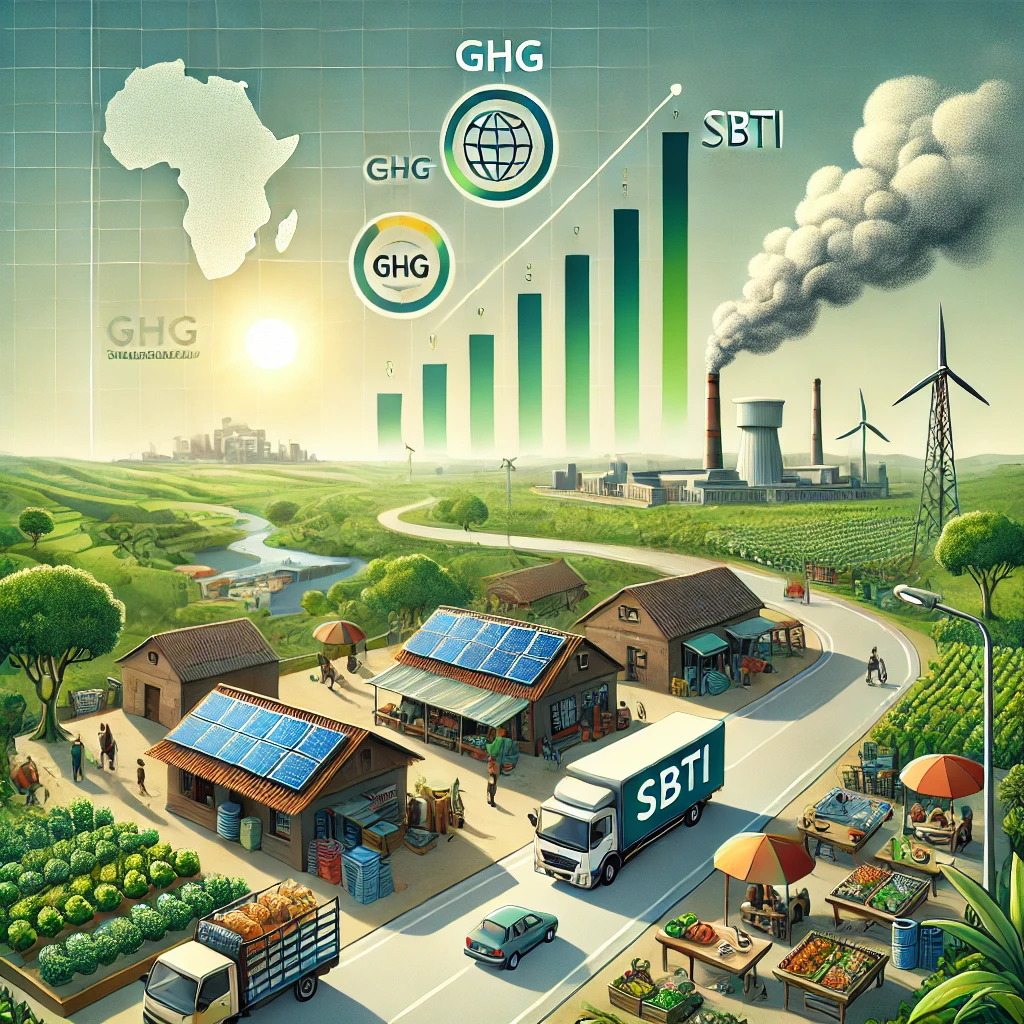As climate action becomes a priority for businesses worldwide, acronyms like GHG (Greenhouse Gases) and SBTi (Science-Based Targets initiative) are central to sustainability conversations. While GHG represents emissions that contribute to climate change, SBTi offers a structured approach to setting reduction targets aligned with climate science. This report explores these concepts, their differences, and their relevance for small and medium enterprises (SMEs) in Sub-Saharan Africa striving to balance growth with sustainability.
GHG: The Foundation of Climate Action
What are Greenhouse Gases?
Greenhouse gases (GHGs) are atmospheric gases that trap heat, contributing to the “greenhouse effect” and global warming. Key GHGs include:
- Carbon dioxide (CO₂): Emitted from burning fossil fuels and deforestation.
- Methane (CH₄): Released during livestock farming and oil and gas production.
- Nitrous oxide (N₂O): Linked to agricultural and industrial processes.
- Fluorinated gases: Synthetic gases used in refrigeration and manufacturing.
Why GHG Emissions Matter
GHG emissions are a major driver of climate change, which poses risks to agriculture, infrastructure, and livelihoods across Sub-Saharan Africa. SMEs contribute to and are affected by these changes, making GHG management critical for long-term resilience and competitiveness.
Measurement and Reporting
Businesses measure GHG emissions in tonnes of CO₂ equivalent (tCO₂e) using frameworks like the GHG Protocol. This helps companies:
- Quantify their climate impact: Understand and track emissions sources.
- Identify reduction opportunities: Implement changes to cut emissions and improve efficiency.
- Respond to stakeholder demands: Meet expectations from regulators, investors, and customers for transparency.
SBTi: Science-Based Climate Goals
What is SBTi?
The Science-Based Targets initiative (SBTi) is a global partnership that helps businesses set emissions reduction targets aligned with the Paris Agreement’s goal of limiting global warming to 1.5°C. It provides:
- Sector-specific guidance: Tailored pathways for industries to decarbonize.
- Validation services: Independent verification of a company’s targets.
- Credibility: Ensures that targets are grounded in scientific research.
The SBTi Process
- Commit: Companies formally commit to setting science-based targets.
- Develop targets: Identify reduction goals for direct and indirect emissions.
- Submit for validation: Have targets reviewed and approved by the SBTi.
- Disclose and act: Report progress transparently and implement reduction strategies.
Relevance for SMEs
SBTi is not just for large corporations. SMEs can participate through the SME Climate Hub, a simplified pathway to set science-based targets without the need for costly audits or extensive resources.
Comparing GHG and SBTi
Although GHG and SBTi are closely related, they serve distinct roles in climate action:
| Aspect | GHG | SBTi |
|---|---|---|
| Definition | Measures the emissions contributing to global warming. | Provides a framework for setting targets to reduce GHG emissions. |
| Focus | Quantifying emissions and identifying sources. | Aligning emissions reductions with global climate goals. |
| Application | Used to assess current climate impact and monitor trends. | Drives future-oriented strategies for emissions reduction. |
| Examples | Emissions inventory, carbon footprint analysis. | Setting a target to reduce emissions by 50% by 2030 in line with the Paris Agreement. |
How GHG and SBTi Work Together
For SMEs in Sub-Saharan Africa, understanding GHG emissions lays the foundation for adopting science-based targets through SBTi. Here’s how they complement each other:
- Measurement to Action:
- GHG measurement identifies emissions sources, providing data for target setting.
- SBTi uses this data to create actionable reduction plans.
- Credibility and Impact:
- Transparent GHG reporting builds trust with stakeholders.
- SBTi certification enhances credibility by aligning actions with global standards.
- Practical Implementation:
- GHG tracking helps businesses monitor progress toward SBTi targets.
- SBTi offers strategies to address emissions from operations and supply chains.
Why This Matters for Sub-Saharan African SMEs
Mitigating Risks and Seizing Opportunities
Climate change disproportionately affects Africa, but proactive SMEs can turn challenges into opportunities by addressing GHG emissions and setting SBTi-aligned targets. Benefits include:
- Operational efficiency: Reducing energy and material use cuts costs.
- Access to green financing: Many investors and lenders prioritize businesses with science-based targets.
- Market competitiveness: Sustainability credentials attract eco-conscious consumers and international partners.
Adapting to Regional Contexts
Sub-Saharan Africa’s SMEs face unique challenges, such as limited access to renewable energy and infrastructure. However, solutions tailored to the local context—like improving energy efficiency, adopting sustainable agriculture, and leveraging carbon offset programs—can help businesses meet SBTi goals.

Conclusion
GHG and SBTi are integral components of a robust climate action strategy. While GHG focuses on understanding emissions, SBTi provides a pathway for reduction in alignment with global climate goals.
For SMEs in Sub-Saharan Africa, adopting these frameworks is not just about compliance but about resilience and growth. By addressing GHG emissions and committing to science-based targets, businesses can position themselves as leaders in sustainability, contributing to both regional development and global climate efforts.
The journey to sustainability starts with understanding your impact—through GHG measurement—and taking bold, science-backed steps to reduce it.


Leave a Reply